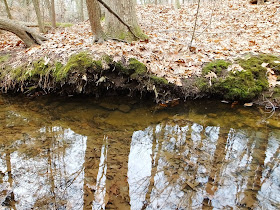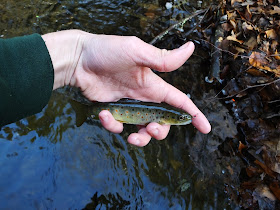Carp
Probably the most prominent reason people fish for trout is because they can be hard to fool into taking a fly. There's so many types of insects to match, so many kinds of water to fish, and so many ways to fish it. It's a challenge - you have to adapt and pay attention to a lot of factors to have a success day on the water.
Striped bass and bluefish offer some of this as well, but it's really their brute strength that keeps so many fly anglers going after them. Even a feisty little schoolie can really pull you around, and a big blue can introduce you to your backing real quick. And add albies to that list, they're probably the most hard fighting species I know.
And bass - largemouth and smallmouth - are great for their availability. Pretty much everyone has a bass pond in their town, and if not, you can almost certainly find bass within a 10 or 15 minute drive.
But what if there was a fish that possessed all these aspects? A fish that was challenging to catch, yet could rip drag off your reel, and was accessible to pretty much everyone? That fish would surely be regarded as the ultimate sportfish…
Well that fish does exist. And it's a carp.
 |
| ( https://upload.wikimedia.org/wikipedia/commons/e/e3/Carp_fly_fishing.jpg) |
I personally can attribute almost every successful aspect of my fly fishing game to carp fishing. The biggest reason why you should give carp a shot (besides all the reasons above!), is because carp fly fishing will make you a much better trout, striper, or bass angler, or a better angler at whatever species you regularly pursue.
I do a majority of my carp fishing in ponds, so here's a few tips on fishing for them in still water...
So what do you need to catch carp?
Everyone prefers different gear, but fortunately a lot of gear will do the trick. I would use a 7 or 8 weight rod just given the size of these fish, so that you can control them when they take massive runs. I have switched around leaders plenty of times, but for most purposes, a 9-12’ mono or fluoro leader is fine in 2 or 3x. You can fish a straight piece of 8-15 lb mono if you're in a budget, and will catch plenty of carp.
Where can you find carp?
Carp are everywhere! Everywhere! If you don't know a carp spot within 30 minutes of you, you probably haven't looked close enough. For starters, almost every body of water in the Connecticut River watershed holds carp, from the river itself to the tributaries to the ponds in the watershed. That goes for MA and CT, and even parts of NH.
I know a lot of viewers on New England Fly Fishing are based around northeastern Massachusetts, which I consider to be one of the capitals for carp fishing in New England. Any of the urban ponds in Boston have them, as well as most of the ponds throughout that region, and the major watersheds like the Mystic, Charles, Merrimack, etc.
When in doubt, ask around. Bait shops and spin fishermen usually don't guard carp spots too closely.
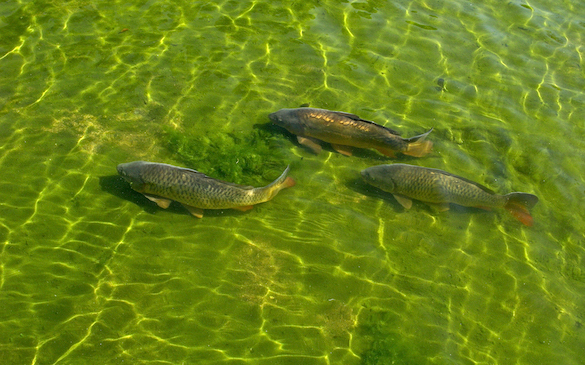 |
| (http://drowningworms.com/wp-content/uploads/2015/06/Carp_in_Herbert_Park_Pond_Dublin.jpg) |
Tactics for ponds
This is where my style of carp fishing differs from a lot of existing techniques, including RM’s. Most carp flies today look something like the ones below, with a pair of dumbbell eyes to keep the fly in the bottom and some sort of buggy material poking out to make the fly attractive.
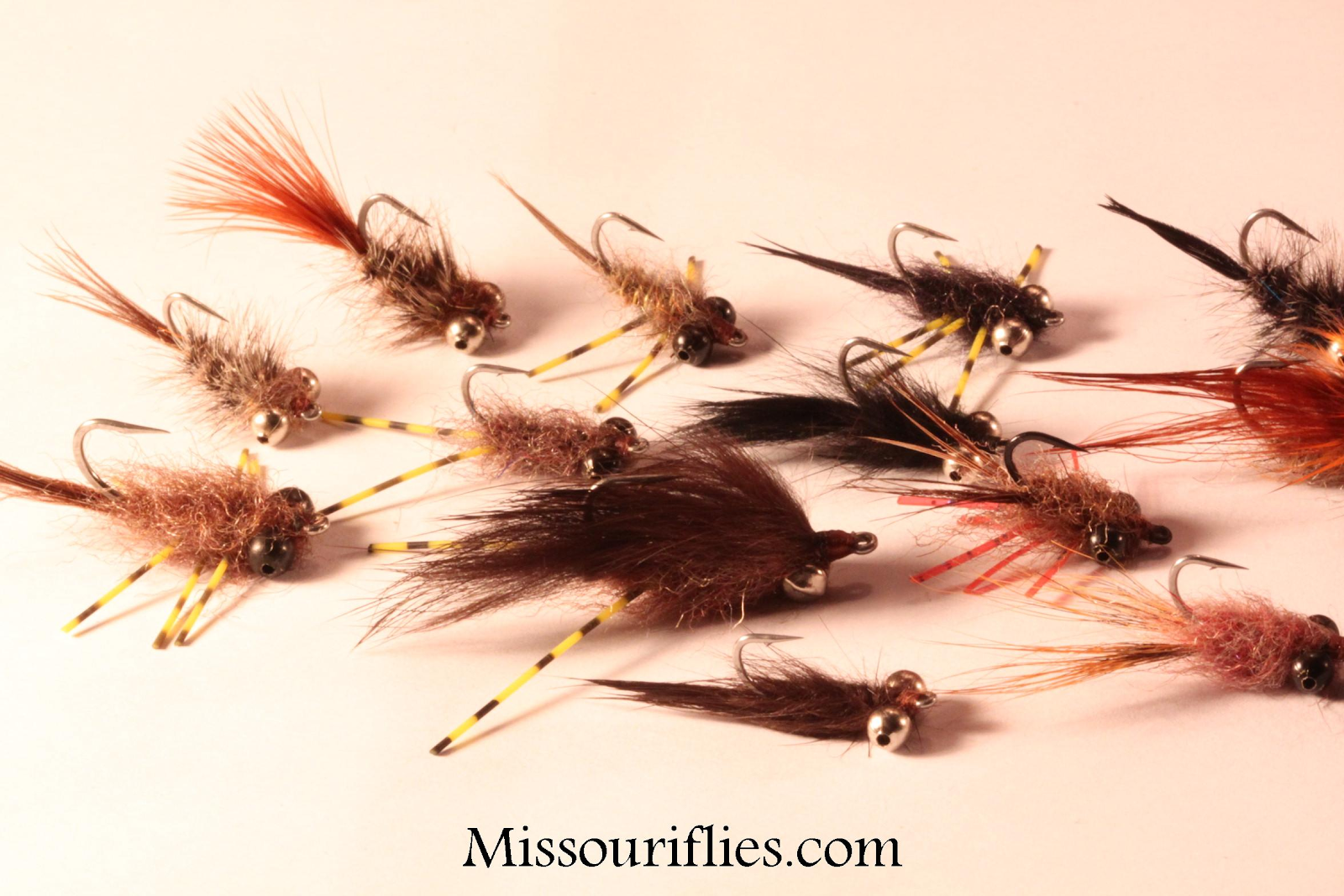 |
| (http://missouriflies.com/wp-content/uploads/2011/06/Carp-Flies.jpg) |
These flies are no doubt effective, and produce a lot of carp, but I just prefer to fish a different way. I'm a sight fishing junky, and love my long, light leaders and unweighted flies. Watching a carp slurp down a slowly sinking fly is as good as it gets to me.
My general strategy for fishing smaller ponds is to get on the water as early as possible, and fish when the sun comes up. Calm, muggy summer days are perfect for this, as being able to see the fish is vital. I can usually deal with clouds, or wind, but if there's both, I'll usually fish for something else.
Then all it comes down to is sighting fish. I cover a lot of ground, cutting through the water with polarized sunglasses. I'm looking for either bubbles at the top (which signal something rooting around on the bottom), tails flapping around, or simply an entire carp. There are two kinds of behavior the carp will usually be exhibiting: tailing or cruising.
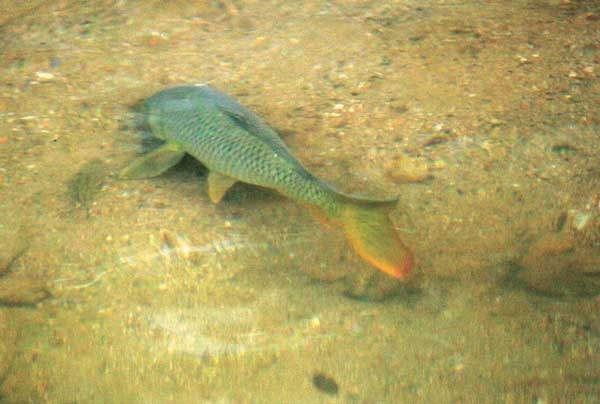 |
| (http://www.carolinasportsman.com/pics/p1277840970.jpg) |
Cruising fish are the easiest targets, because more often than not they are catchable. The trick is to lead the carp with your fly just enough to gain its interest, but not too close or you'll spook it. 3 to 5 feet usually works for me, and mess around with your flies when you first get on the water to determine how far you will have to lead a cruiser to have the fly line up with the fish’s head. And every now and then, usually in the hot summer months, the fish will become so sluggish that they can't be bothered to move for flies. You'll see then just basking below the surface, hardly moving. This can be the toughest time to catch, but to pull it off you need to usually land the fly right on the fish and keep it right in front of its face. These fish are really lazy at this time of the year, and really will not exert energy to get the food, so most of my fish in these small, shallow ponds under these conditions are caught by literally bumping the fly into the carp’s nose. Half the time it will slurp the fly in and in the rest of the time, just keep casting at them. I'm not entirely sure why the carp in these small ponds sometimes get so sluggish in the dead of summer, but I suspect it has to do with the prominence of food (hot, sunny days produce a lot of aquatic vegetation), and that they mainly feed at night this time of year.
Tailers are when the carp is rooting around in the bottom or slurping algae off a rock or wall, with its tail waving above it. This is better suited for the bottom flies I mentioned earlier, but you can pull it off with the unweighted flies. Just aim your cast beyond the fish, let it sink down, and then spot manipulate the fly by stripping it right in front of the fish’s face. Sometimes the fish will look up from the bottom and see the fly (sometimes even chasing it down!), and sometimes you have to let the fly fall all the way down where it is vacuumed up.
The flies I'm using are usually very simple, because carp will pretty much eat anything. My favorites are glo bugs in sizes 6-14, especially in white, yellow, and peach. These are easy to tie, and have a fantastic slow sinking action that carp can’t resist. You can use pom-poms and superglue if you want to make it even easier for yourself. Something I'll also use is just a size 4-8 hook wrapped with some light colored chenille all the way up the shank, or covered in dubbing. I rarely add weight to any of these flies. And white is my go to color.
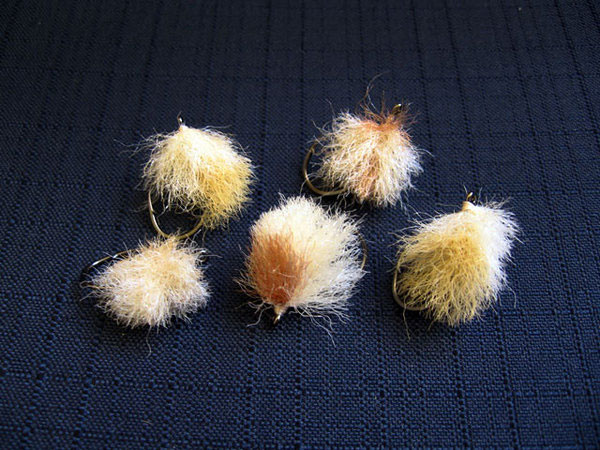 |
| (http://www.flyfishdiary.com/wp-content/uploads/2010/09/bread-flies.jpg) |
For timing, as I have said, for unweighted fly carpin’, summer is as good as it gets. Late May to early June is before the spawn and fish will be feeding heavily, and same with late June. But you don't have to wait, carp can be caught on the fly year round, especially right after ice out when they start to gorge on the available food. In the winter months look for then in fallen trees and cover, where they will tend to sit motionless until the sun heats the water in the afternoon, triggering a feast.
Finally, you should fish for carp to protect your local trout. The strategies I have talked about are pretty much only applicable from late April to September, with the best times being the three summer months. And with the heat and droughts we've been having recently, a lot of trout fisheries are under a lot of pressure in the summer months, and really should be left alone. So instead of fishing for trout when the water gets too warm, switch over to carp, which will be completely fine in these conditions. And once you feel the power of a carp, your trout may start getting a lot more time off.
You can reach me in the comments here or at
noeldawes1983@gmail.com if you have any questions. Spots, flies, and more, I'm happy to help.
Photo credits
-Carolina Sportsman
-Fly Fish Diary
-Missouri Flies
-Drowning Worms
















